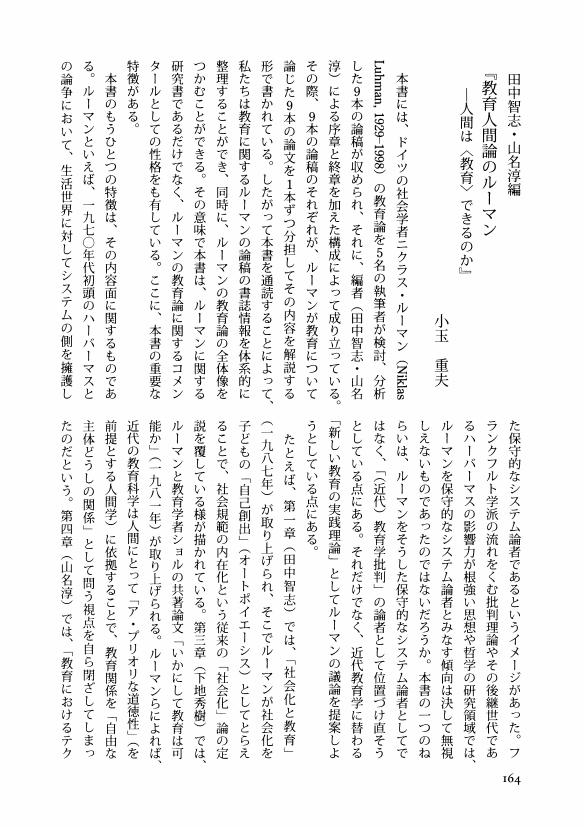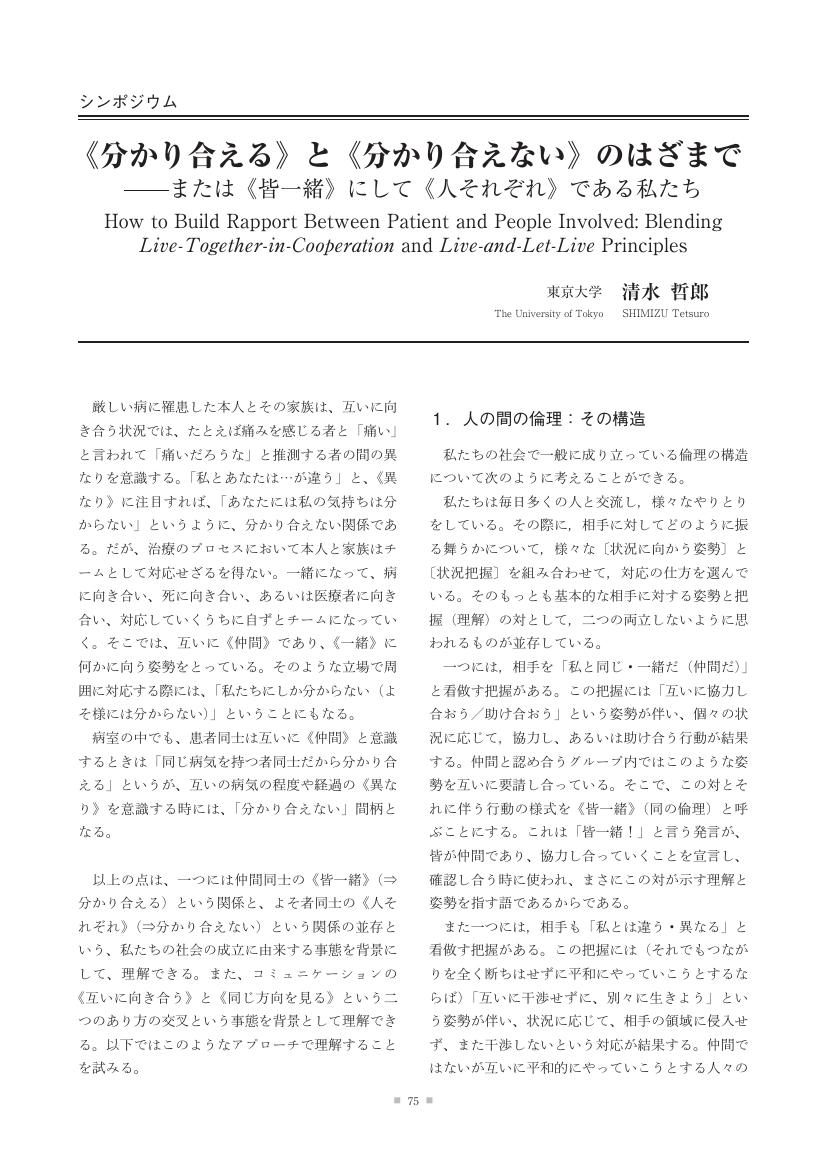4 0 0 0 OA カント道徳論に対するルソーの影響 ルソーの合理主義とカントの「理性の事実」の問題
- 著者
- 中村 博雄
- 出版者
- 日本哲学会
- 雑誌
- 哲学 (ISSN:03873358)
- 巻号頁・発行日
- vol.1986, no.36, pp.152-162, 1986-05-01 (Released:2009-07-23)
4 0 0 0 IR バシュラールとセール : エピステモロジーの一系譜
- 著者
- 上野 隆弘 Ueno Takahiro
- 出版者
- 大阪大学大学院人間科学研究科『共⽣学ジャーナル』編集委員会
- 雑誌
- 共生学ジャーナル (ISSN:24326755)
- 巻号頁・発行日
- no.3, pp.96-117, 2019-03
論文本稿では、ミシェル・セールをガストン・バシュラールの後継者として位置付け、エピステモロジーの一系譜を描きだすことを目標とする。一般的にライプニッツ主義者として知られているセールであるが、初期の仕事はバシュラールの影響を受けていた。本稿では、四つのテーマのもと両者の関係性を探究する。はじめに、バシュラールの設定した科学と詩の分割を確認し、両者を統合しようとするセールの議論を追う。次に、その統合の結果として提示されるセールの新しい科学史観を確認する。その後、セールによるバシュラールのイデオロギー批判を論じ、最後に、セールがどのようにバシュラールが保持していた主観性の哲学を抹消するのかを示す。The aim of this paper is to determine Michel Serres as a successor of Gaston Bachelard and present a genealogy of epistemology[épistémologie]. Generally speaking Serres is known as a Leibnizian, but his early works are influenced by Bachelard. We inquire their relationship under four themes. Firstly, we confirm Bachelard's division of sciences and the poetry and follow Serres's discussion that tries to unite these two fields. Secondly, we confirm Serres's new perspective of history of science as a result of this union. Thirdly, we discuss the Serres's criticism against Bachelard's ideology. Finally, we present how Serres erases the philosophy of subjectivity that Bachelard maintains.
4 0 0 0 OA 近代青年と教養 : 教養主義を超えて (<特集>教養の解体と再構築)
- 著者
- 北村 三子
- 出版者
- 一般社団法人 日本教育学会
- 雑誌
- 教育学研究 (ISSN:03873161)
- 巻号頁・発行日
- vol.66, no.3, pp.268-277,366, 1999-09-30 (Released:2007-12-27)
教養主義とは、明治の末(ほぼ1910年代)に日本の知識人たちの間に成立した、人間性の発達に関する信条(あるいは「主義」)である。ドイツの教養(ビルドゥンク)概念の影響の下に、若いエリートたちは、人類の文化、ことに、西洋の哲学、芸術、科学などを継承することを通して人格者になりたいと思った。彼らはそれらの偉大な作品に触れることによって強められた理性と意志が人間の行動を制御すると期待した。彼らはある程度それに成功したが、同時に、大地や他者から切り離されてしまったと感じ、不安に悩まされるようになった。 教養主義は主に旧制高校生や大学生の間に普及したが、かれら若きエリートたちは、深層意識では、自分を高等教育には手が届かない若者たちと区別したかったのだ。その意味で、教養主義はかなりスノビッシュなものである。 この教養主義の欠点は、第二次大戦後、日本の教育関係者たちによって批判された。批判者の一人で、新時代のリーダーの一人であった勝田守一は、新しい教養の概念を提案した。それは、高く評価された人類の労働を基盤にしたものであった。勝田によれば、労働は人間の諸感覚、思考能力、コミュニケーション能力を発達させてきた。その中でも、近代に著しく発達した科学的思考法は、私たちにとって最も大切なものなのである。そこで勝田は、教養のある人間は、人類が発達させてきた諸能力を偏ることなしに身に付けていなければならならず、そうすることによって、教養人は社会を進歩させるであろうと主張した。人類の能力は無限に発達すると勝田は信じた。なぜなら、近代科学技術の発展には限界がないように見えたからである。 私たちはもはやこのような楽観的な見解には同意できない。なぜなら、近代の科学技術が自然に対して攻撃的であり、地球の生態系に重大なダメージを与えうることを、私たちは知ってしまったからだ。勝田の教養概念や教養主義をこの観点からもう一度振り返るならば、それらには、思考方法において共通の欠陥があることに気が付く。それは、近代思想一般に見られる欠点と同じものである。 近代的知性は生産的である。それは物を作り出すだけではなく、表象や概念や推論を用いて事物のリアリティを生み出すのだ。その思考法は、利用という観点からだけ事物と関わるものであり、人間中心的で、事物に耳を傾け対話することはない。鮮明に意識に表象されない事物は、意味がないとみなされ、無視される。あの若き教養主義者たちの心の葛藤も、おそらく、この近代の知性の産物である。 教養が再構築されねばならないとしたら、それは、これまでとは異なる思考やコミュニケーションの方法を基盤とするものでなければならないだろう。また、近代的な労働や社会の中でおそらくは失われてきた諸感覚や能力を回復できるものでなければならない。
4 0 0 0 OA S.R.ランガナタンの「1 つの世界」観と「科学的方法」について
- 著者
- 吉植 庄栄
- 出版者
- 東北教育哲学教育史学会
- 雑誌
- 教育思想 (ISSN:03860663)
- 巻号頁・発行日
- vol.47, pp.83-106, 2020-03-31
4 0 0 0 OA ライプニッツにおける「慈愛」(caritas)の概念
- 著者
- 酒井 潔
- 出版者
- 学習院大学
- 雑誌
- 人文 (ISSN:18817920)
- 巻号頁・発行日
- vol.8, pp.7-20, 2009-03
ライプニッツのcaritas 概念は、一方で伝統的なキリスト教の立場に、他方で十七世紀の啓蒙主義の時代思潮にそれぞれ連続する面を有する。「正義とは賢者の慈愛である」(Justitia est caritassapientis)、そして「慈愛とは普遍的善意(benevolentia universalis)である」というライプニッツの定義には、キリスト教的な「善き意志」のモチーフとともに、(プラトニズム起源のものだけではない)近代の合理主義的性格が見出される。ライプニッツは彼の政治学、ないし政治哲学の中心にこのcaritas 概念をすえている。それは彼の「社会」(societas)概念とも密接にリンクしつつ、今日の社会福祉論への射程を示唆する。ライプニッツの「慈愛」、「幸福」、「福祉」(Wohlfahrt)という一連の概念のもつ広がりは、アカデミー版第四系列第一巻に収載されている、マインツ期の覚書や計画書に記載された具体的な福祉政策(貧困対策、孤児・浮浪者救済、授産施設、福利厚生など)に見ることができる。しかしcaritas 概念の内包を改めて検討するならば、caritas 概念の普遍性と必然性は、その最も根底においては、ライプニッツの「個体的実体(モナド)」の形而上学に基礎づけられている、ということが明らかになるであろう。In Leibniz' philosophy we find the very basic notion that philosophers, who recognize or are able to recognize that this world has been created by God, should try to bring about "the happiness of human beings, the benefit of society and the honor of God". This is precisely where the concept of "charity" as the "justice of the wise" is being conceived("Justitia est caritas sapientis"). Leibniz thinks that caritas can be equated neither with mere compassion nor with a particular religious virtue. For a rational human being, caritas belongs to the universal duties of practical life. Such a science - one that is called "politica" by Leibniz - is a discipline of practical philosophy. Leibniz' concept of caritas has two principal aspects: on one hand it has a traditional aspect deriving from Christian Antiquity and the Middle Ages; on the other hand it has a rational character derived from the idea that caritas must be based on reason and its proven knowledge. In this sense we can confirm that Leibniz belonged to that early idealistic period of the Enlightenment in the 17th century.
4 0 0 0 OA 墨子・揚子 : 現代語訳
4 0 0 0 OA 田中智志・山名淳編『教育人間論のルーマン-人間は〈教育〉できるのか』
- 著者
- 小玉 重夫
- 出版者
- 教育哲学会
- 雑誌
- 教育哲学研究 (ISSN:03873153)
- 巻号頁・発行日
- vol.2006, no.93, pp.164-166, 2006-05-10 (Released:2010-05-07)
4 0 0 0 OA カントにおける道徳教育方法論の思考法
- 著者
- 中沢 哲
- 出版者
- 教育哲学会
- 雑誌
- 教育哲学研究 (ISSN:03873153)
- 巻号頁・発行日
- vol.2001, no.83, pp.60-75, 2001-05-10 (Released:2010-05-07)
- 参考文献数
- 39
Der Zweck dieses Aufsatzes ist Kants Methodenlehre der moralischen Erziehung zurekonstruieren, indem der Vf. Kants Denkart einer Methode der moralischen Erziehung im Zusammenhang mit der Denkart der Beziehung zwischen “dem naturlichen gesunden Verstande” und dem Begriff des guten Willens in der Grundlegung zur Metaphysik der Sitten betrachtet, urn dadurch Kants Absicht in der Methodenlehre zu klären.Die moralische Erkenntniskraft des Schülers ist die “gemeine Menschenvernunft”. Kant schlagt ein “Bruchstiick eines moralischen Katechismus” als Methode der moralischen Erziehung vor (Metaphysik der Sitten). Dieser sokratische Katechismus wird aus der gemeinen Menschenvernunft im Kind entwickelt. Der Schiüler antwortet mit seinem guten Verstand. Dadurch wird der Schiüler sich “eines solchen guten und tätigen Willens” bewußt.Die gemeine Menschenvernunft ist der Ausgangspunkt der Entwicklung der Moralphilosophie in der GMS. Kant behauptet, daß der Begriff des guten Willens dem natürlichen gesunden Verstand (der gemeinen Menschenvernuft) beiwohne. Dieser Begriff ist aber bei ihm nicht klar. Kant hat ihn in der GMS geklärt. Das Urteil der gemeinen Menschenvernuft hat seinen Ursprung im Wollen des guten Willens.Das moralische Prinzip für den Lehrer, der in der moralischen Erziehung “sokratisch zu katechisieren versucht”, ist die “dunkel gedachte Metaphysik”, d. h. der Begriff des guten Willens. Der Schüer wird durch die moralische Erkenntnistatätigkeit sich des eigenen Wollens des guten Willens klar bewußt. Die Denkart der Beziehung zwischen “dem natürlichen gesunden Verstande” und dem Begriff des guten Willens in der GMS entspricht Kants Denkart in der Methodenlehre der moralischen Erziehung. Das moralische Urteil des Kindes hat seinen Ursprung im eigenen moralischen Wollen. Es ist der erste Schritt zu einer “Revolution in der Gesinnung”, sich dieses Wollens bewußt zu sein.
4 0 0 0 OA アーノルド・ゲーレン「制度の哲学」の教育学的意義
- 著者
- 岡谷 英明
- 出版者
- 教育哲学会
- 雑誌
- 教育哲学研究 (ISSN:03873153)
- 巻号頁・発行日
- vol.1995, no.72, pp.16-30, 1995-11-10 (Released:2009-09-04)
- 参考文献数
- 28
Stehen 'Institutionen' im Gegensatz zu Freiheit oder nicht? Zweck dieser Arbeit ist es, 'Institutionen' und die ober die Entfremdung durch 'Institutionen' sich entfaltende menschliche Freiheit zu diskutieren.Zunächst soil das Ploblembewußtsein in Arnold Gehlen's “Philosophie der 'Institution-en” ins Blickfeld gerUckt werden urn damit zu einem besseren Verständnis des Begriffs der Institution zu gelangen. Sodann wird der Inhalt von Gehlen's 'Institution' mit Hegel's 'objektivem Geist' verglichen. Dadurch soli eine Klärung des Begriffs 'Institution' erreicht werden. Endlich wird versucht, den Prozeß aufzuhellen, wie in der 'Institution' der Mensch zum Menschen wird.
- 著者
- 清水 哲郎
- 出版者
- 日本医学哲学・倫理学会
- 雑誌
- 医学哲学 医学倫理 (ISSN:02896427)
- 巻号頁・発行日
- vol.34, pp.75, 2016 (Released:2018-05-07)
4 0 0 0 OA アドボカシーは看護者の役割か
- 著者
- 石川 洋子
- 出版者
- 日本医学哲学・倫理学会
- 雑誌
- 医学哲学 医学倫理 (ISSN:02896427)
- 巻号頁・発行日
- vol.28, pp.1-9, 2010-09-24 (Released:2018-02-01)
Advocacy in nursing, is a central concept in terms of protecting the interests and rights of patients as well as establishing and improving the expertise and social status of nurses. In fact, advocacy is a role played not only by nurses, but by all medical professionals. Advocacy is an important concept for nursing with extensive meaning and contents. Consequently, confusion can occur due to the uncertainty advocacy poses for nursing practice. Moreover, advocacy is accompanied by risk and difficulty, and there are no clear guidelines on how to implement it. It is necessary to enhance education and improve the workplace environment to practice advocacy effectively. It is also essential that nurses reconsider their values and how they support patients while collaborating with other medical professionals.
4 0 0 0 OA 法学者の立場から : 「死ぬ権利」と刑法(シンポジウム1 死ぬ権利はあるか)
- 著者
- 川口 浩一
- 出版者
- 日本医学哲学・倫理学会
- 雑誌
- 医学哲学 医学倫理 (ISSN:02896427)
- 巻号頁・発行日
- vol.17, pp.203-210, 1999-10-01 (Released:2018-02-01)
4 0 0 0 OA 観測と宇宙 多世界解釈の哲学
- 著者
- 藤田 晋吾
- 出版者
- 科学基礎論学会
- 雑誌
- 科学基礎論研究 (ISSN:00227668)
- 巻号頁・発行日
- vol.20, no.2, pp.97-102, 1991-03-25 (Released:2009-09-04)
- 参考文献数
- 12
4 0 0 0 OA 社会科学方法論の現状と科学哲学
- 著者
- 富永 健一
- 出版者
- 科学基礎論学会
- 雑誌
- 科学基礎論研究 (ISSN:00227668)
- 巻号頁・発行日
- vol.7, no.4, pp.156-163, 1966-03-30 (Released:2009-09-04)
4 0 0 0 OA 信原幸弘著『情動の哲学入門』
- 著者
- 服部 裕幸
- 出版者
- The Philosophy of Science Society, Japan
- 雑誌
- 科学哲学 (ISSN:02893428)
- 巻号頁・発行日
- vol.51, no.2, pp.91-94, 2018-12-30 (Released:2019-11-27)
4 0 0 0 OA 染谷昌義著『知覚経験の生態学―哲学へのエコロジカル・アプローチ』
- 著者
- 源河 亨
- 出版者
- The Philosophy of Science Society, Japan
- 雑誌
- 科学哲学 (ISSN:02893428)
- 巻号頁・発行日
- vol.51, no.2, pp.83-86, 2018-12-30 (Released:2019-11-27)
4 0 0 0 OA 美的性質と知覚的証明
- 著者
- 源河 亨
- 出版者
- The Philosophy of Science Society, Japan
- 雑誌
- 科学哲学 (ISSN:02893428)
- 巻号頁・発行日
- vol.47, no.2, pp.87-103, 2014-12-20 (Released:2015-11-08)
- 参考文献数
- 24
- 被引用文献数
- 1
According to the Sibleyan account, descriptive aesthetic judgments are warranted by aesthetic perception. I defend this account by using a philosophical theory of perceptual experience, that is, Fregean intentionalism. I will then suggest an anti-realistic account of aesthetic properties, which claims that perceivable aesthetic properties are not realistic properties supervening on sets of non-aesthetic sensible properties (e.g. color, shape, etc.) of objects, but some kind of “modes of presentation” of such properties. Proving this argument, I demonstrate how the philosophy of perception can be useful for considering problems in aesthetics.
4 0 0 0 OA 第2 回石本基金若手研究助成・成果報告書 知覚と概念
- 著者
- 村井 忠康
- 出版者
- The Philosophy of Science Society, Japan
- 雑誌
- 科学哲学 (ISSN:02893428)
- 巻号頁・発行日
- vol.45, no.2, pp.99-114, 2012 (Released:2016-01-15)
- 参考文献数
- 24
According to the standard form of conceptualism, which comes from McDowell (1994), the conceptual content of experience is propositional. But this is at variance with naive realism, which conceptualism craves for. Given that, we should seek non-propositionalist forms of conceptualism, which make room for naive realism. In this paper I propose such a conceptualism, exploiting Sellarsʼs idea of visual experience as “thinking in color”, although he himself has never been conceptualist. Elaborating the idea will lead to the conception of visual experience as analogous, in a unique way, to drawing a picture. I argue that this enables conceptualism to take seriously the particularity and concreteness of perception, which are emphasized by naive realism.
4 0 0 0 OA 伊佐敷隆弘著『時間様相の形而上学』を読んで
- 著者
- 佐金 武
- 出版者
- The Philosophy of Science Society, Japan
- 雑誌
- 科学哲学 (ISSN:02893428)
- 巻号頁・発行日
- vol.44, no.1, pp.1_59-1_74, 2011 (Released:2011-10-13)
- 参考文献数
- 18
In his book Metaphysics of Temporal Modality, Prof. Isashiki takes a very unique and intriguing approach to philosophy of time. He begins with raising the following three questions. (i) What does it mean to say that the past is determinate or fixed whereas the future is open? (ii) Why is it impossible to see temporal transition from the present to the past? (iii) Does the present have no duration? Answering to those questions, he declares that he does not assume any linear representation of time. In this review, I shall examine to what extent the attempt succeeds and in what respects it fails.
4 0 0 0 OA パースの量化論理について
- 著者
- 石田 正人
- 出版者
- 日本科学哲学会
- 雑誌
- 科学哲学 (ISSN:02893428)
- 巻号頁・発行日
- vol.34, no.2, pp.59-74, 2001-11-10 (Released:2009-05-29)
Quantificational logic was developed by some ingenious mathematicians towards the end of the 19th century, especially during the 1880's. It was indeed, as Quine once wrote, a decade when quantification was "breaking out all over". While it is acknowledged that Peirce was among those founders of modern logic, his specific achievements and contribution to the field seem to deserve more notice. The present paper focuses on the emergence of Peirce's quantificational logic, deriving most of the material from his original writings. We shall also glance through O. H. Mitchell's work, which is little discussed in the history of logic.







